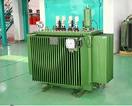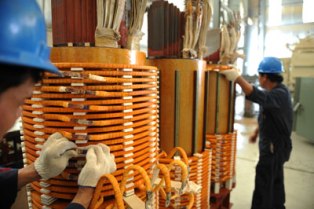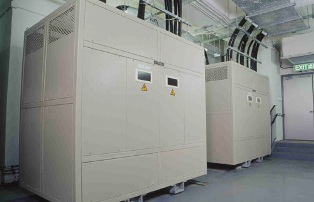Malfunctions in the operation of power transformers
During operation, the appearance of various types of defects and malfunctions of transformers, affecting their operation to varying degrees, is not excluded. In some faults, transformers can remain in service for a long time, in others they must be immediately taken out of service. In any case, the possibility of further work is determined by the nature of the damage. Incapacity of personnel, untimely adoption of measures aimed at eliminating sometimes minor defects lead to emergency shutdowns of transformers.
The causes of the damage are unsatisfactory working conditions, poor quality repair and installation of transformers. Defects of individual structural elements of modern transformers, the use of insufficient quality insulating materials.
Damage to insulation, magnetic circuits, switching devices, turns, oil-filled and porcelain bushings is typical.
Damage to the insulation of transformers
 The main insulation is often damaged due to a violation of its electrical strength when wet, as well as in the presence of small flaws. In transformers 220 kV and higher, failures are associated with the occurrence of the so-called "creeping discharge", which is a gradual destruction of the insulation by the spread of local discharges on the surface of the dielectric under the action of the operating voltage. On the surface insulation, a grid of conductive channels appears, while the calculated insulation gap is reduced, which leads to the destruction of the insulation with the formation of a powerful arc inside the tank.
The main insulation is often damaged due to a violation of its electrical strength when wet, as well as in the presence of small flaws. In transformers 220 kV and higher, failures are associated with the occurrence of the so-called "creeping discharge", which is a gradual destruction of the insulation by the spread of local discharges on the surface of the dielectric under the action of the operating voltage. On the surface insulation, a grid of conductive channels appears, while the calculated insulation gap is reduced, which leads to the destruction of the insulation with the formation of a powerful arc inside the tank.
The intense thermal wear of the coil insulation is caused by the swelling of the additional insulation of the coils and the associated cessation of oil circulation due to partial or complete blocking of the oil passages.
Mechanical damage to the insulation of the coils often occurs when short circuits in the external electrical network and insufficient electrodynamic resistance of the transformers, which is the result of a weakening of the efforts to press the windings.
Damage to magnetic cores of transformers
Magnetic circuits are damaged due to overheating due to the destruction of the varnish film between the sheets and sintering of steel sheets, in the case of breaking the insulation of the press pins, in the case of a short circuit, when individual elements of the magnetic circuit turn out to be closed to each other and to the tank .
Failure of switching devices of transformers
Failure of PMB switching devices occurs when contact is broken between the movable slip rings and the stationary conductor rods.Deterioration of the contact occurs with a decrease in the contact pressure and the formation of an oxide film on the contact surfaces.
Changer switches are quite complex devices that require careful adjustment, inspection and special tests. The causes of failure of the load switch are malfunctions in the operation of contactors and switches, burnt contacts of contactor devices, jamming of contactor mechanisms, loss of mechanical strength from steel parts and paper-bakelite wadding. Recurring accidents associated with failure of the regulating coil resulting from the overlap of the outer gap of the protective spark gap.
Failure of the taps from the windings to the switching devices and bushings is mainly caused by the unsatisfactory condition of the rations. contact links, as well as the approach of flexible outlets to the walls of the tanks, contamination of the oil with conductive mechanical impurities, including oxides and metal particles from cooling systems.

Damage to transformer bushings
Failure of bushings 110 kV and above is mainly related to wetting of the paper base. Moisture penetration into the bushings is possible if the seals are of poor quality, when topping up the bushings transformer oil with low dielectric strength. Note that the failure of bushings, as a rule, is accompanied by transformer fires, causing significant damage.
A typical cause of failure of porcelain bushings is contact heating in threaded joints of composite conductive pins or at the connection point of external busbars.
Protection of transformers from internal damage
Transformers are protected from internal damage relay protection devices... The main high-speed protections are differential current protection against all types of short-circuits in the windings and at the terminals of the transformer, gas protection against short-circuits occurring inside the transformer tank and accompanied by the release of gas and by {lowering the oil level, current interrupt there is no time delay from a transformer failure accompanied by the passage of relatively large short-circuit currents.
All protections against internal damage operate when all transformer breakers are turned off, and at substations made according to simplified schemes (without breakers on the HV side) — when a short-circuit breaker is closed or a power line breaker is turned off.

Monitoring and detection of transformer health damage occurring in them by analysis of gases dissolved in oil
To detect faults on transformers at the earliest possible stages of their occurrence, when the gas release can still be very weak, in operational practice they are widely used by chromatographic analysis of gases dissolved in oil.
The fact is that with developing transformer failures caused by high-temperature heating, oil and solid insulation decompose with the formation of light hydrocarbons and gases (with a rather specific composition and concentration), which dissolve in oil and accumulate in the gas relay of the transformer. The period of gas accumulation in the relay can be quite long, and the gas accumulated in it can differ significantly from the composition of the gas taken near the place of its release.Therefore, fault diagnosis based on the analysis of the gas taken from the relay is difficult and may even be delayed.
The analysis of a gas sample dissolved in oil, in addition to a more accurate diagnosis of the fault, makes it possible to observe its development before triggering the gas relay. And even in the case of large damage, when the gas protection is activated when the transformer is tripped, the comparison of the compositions of the gas taken from the relay and dissolved in the oil can be useful for a more correct assessment of the severity of the damage.
The composition and limit concentrations of gases dissolved in oil, transformers in good condition and with typical types of damage were determined. For example, when oil is decomposed under the action of an electric arc (overlap in the switch), hydrogen is mainly released. Of the unsaturated hydrocarbons, acetylene predominates, which in this case is a characteristic gas. Carbon monoxide and carbon dioxide are present in small amounts.
And here is the gas released during the decomposition of oil and solid insulation (closing from turn to turn in the winding) differs from the gas formed only during the decomposition of oil in a noticeable content of oxide and carbon dioxide
In order to diagnose damage from transformers periodically (2 times a year) take oil samples for chromatography analysis of gases dissolved in oil, while medical syringes are used to take oil samples.
Sampling of oil is carried out as follows: cleaned of dirt on the branch pipe of the valve intended for sampling, a rubber hose is placed on the branch pipe.The tap is opened and the hose is flushed with oil from the transformer, the end of the hose is lifted up to remove air bubbles. A clamp is installed at the end of the hose; the needle of the syringe is injected into the wall of the hose. Get the oil in the syringe and then! the oil is drained through the washing needle of the syringe, the operation of filling the syringe with oil is repeated, the syringe filled with oil is injected with the needle into the rubber stopper and in this form is sent to the laboratory.
The analysis is carried out in laboratory conditions using a chromatograph. The results of the analysis are compared with the aggregated data on the composition and concentration of gas released during various types of transformer failures, and a conclusion is made about the serviceability of the transformer or its failures and the degree of danger of these failures.
By the composition of gases dissolved in oil, it is possible to determine overheating of conductive connections and structural elements of the transformer frame, partial electric discharges in oil, overheating and aging of the solid insulation of the transformer.
